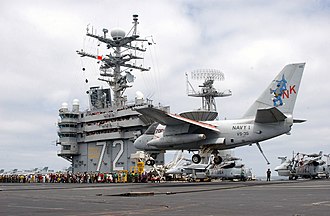| Navy One | |
|---|---|
 Navy One landing on the USS Abraham Lincoln with President George W. Bush | |
| General information | |
| Type | S-3 Viking |
| Manufacturer | Lockheed |
| Serial | BuNo 159387 |
| History | |
| Preserved at | National Naval Aviation Museum |

Navy One is the call sign of any United States Navy aircraft carrying the president of the United States. [1]
There has only been one aircraft designated as Navy One: a Lockheed S-3 Viking, BuNo 159387, assigned to the "Blue Wolves" of VS-35, which transported President George W. Bush to the aircraft carrier USS Abraham Lincoln off the coast of San Diego, California, on 1 May 2003. The pilot was Commander John "Skip" Lussier, then VS-35's executive officer; and the flight officer was Lieutenant Ryan "Wilson" Phillips. [2] The S-3 used for the flight was retired from service and placed on display at the National Naval Aviation Museum in Pensacola, Florida, on 17 July 2003. [3] [4]
When President Donald Trump boarded the USS George H.W. Bush pierside at Naval Station Norfolk on October 5, 2025, he said the ship would "be Navy One, like Air Force One" for the day. [5]
A Navy aircraft carrying the vice president would be designated Navy Two.